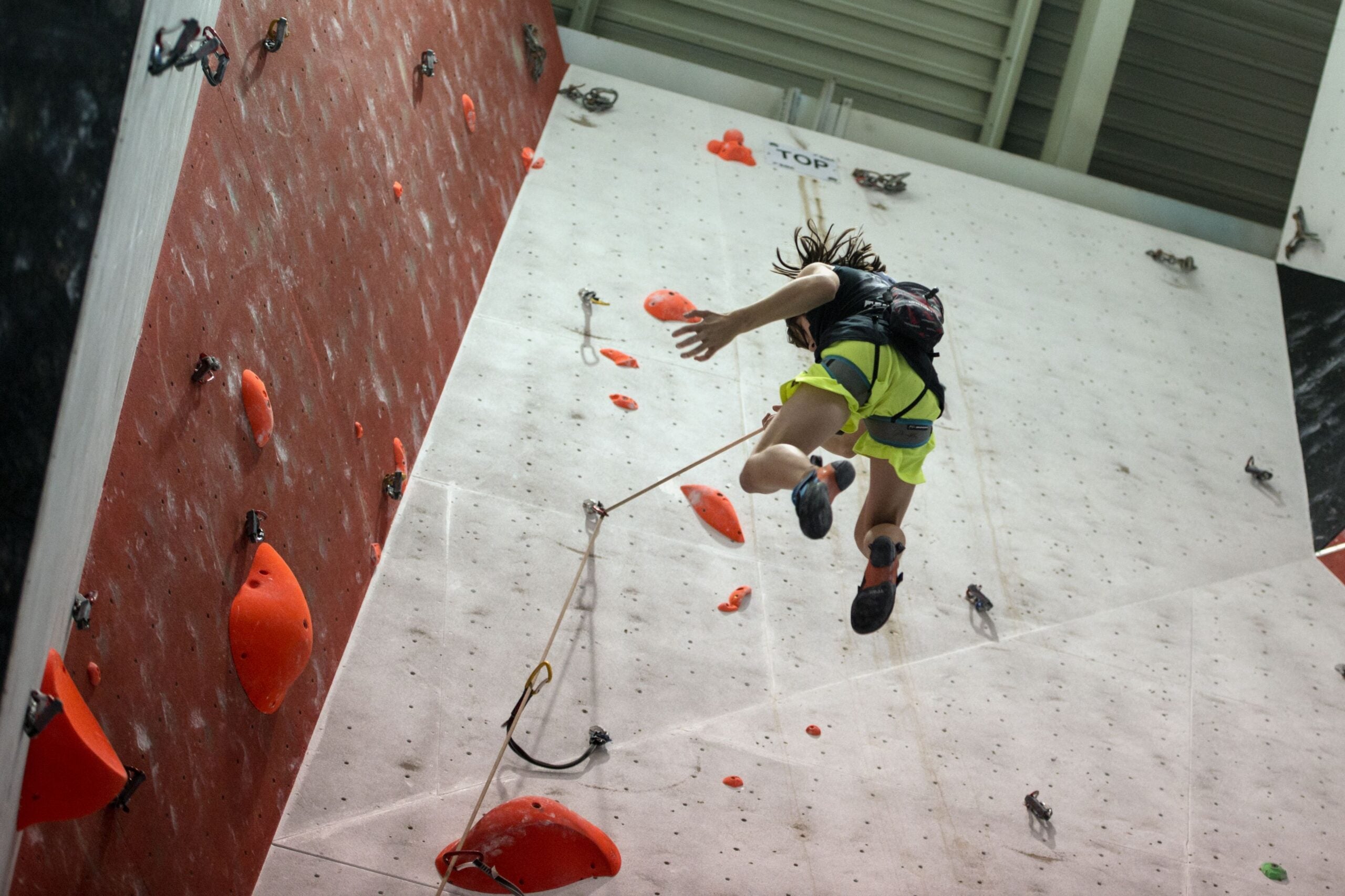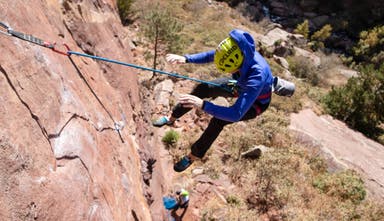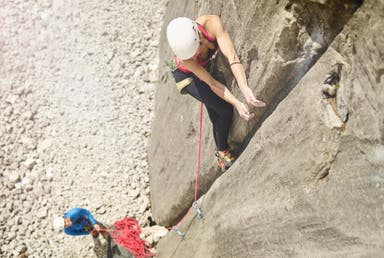How to Conquer Your Fear of Falling (Even in the Gym)

(Photo: Oli Scarff / Getty )
Anyone who tells you they’ve never been scared to take a climbing fall is lying. Falling is scary. It’s scary for beginners and lifelong experts alike. Over my 10 years writing about climbing, I’ve interviewed pros, coaches, and mountain guides who have all confessed that they still get scared to fall from time to time. Even these experts work diligently to keep that fear in check. Hell, I have to re-teach myself how to fall at the start of every season—no matter how fearless I felt just months before.
“100% of climbers could do with working on their head game,” says Kevin Roet, author of Climbing Psychology and owner of UK guiding outfit Rise and Summit. The human brain isn’t wired to love leaping from great heights. Being afraid to fall is very normal—and very human.
Some people feel embarrassed to be scared of falling in the controlled environment of a gym, but it happens all the time. Whether you’re bouldering, leading, or even toproping, you can still get scared indoors. The good news is that fear isn’t something you’re stuck with, even if it feels insurmountable now. If you do the work, you can chip away at this anxiety until it’s something you barely think about.
Now for the bad news: While we all love a quick fix, there’s no single drill, mantra, or breathing technique that’s going to banish your fear for good, says Roet. That’s because fear looks different for everyone.
Our Picks
To start working on your particular brand of falling fear, you’ll need a few ingredients: 1. a clear idea of what scares you, 2. an understanding of your fear threshold, and 3. a plan for working through that fear piece by piece.
Identify your stressors
First, figure out what scares you about falling in the gym. Are you afraid of getting hurt? Of the rope breaking? Of embarrassing yourself?
If fear of embarrassment is the primary stressor, try climbing with someone whose opinion you don’t care about. Find a partner who’s at or below your ability level, or someone who isn’t your mentor or significant other. It might also be helpful to reevaluate why you climb. If you’re putting too much pressure on yourself, figure out where that pressure is coming from.
Are you afraid of getting dropped or spiked into the wall? You may want to switch belayers. Even if your regular climbing partner is pretty competent, getting belayed by a coach or expert can be an incredible way to develop trust with the training wheels on, says Roet. Most gyms offer a learn-to-lead class or instructors you can book a one-on-one clinic with.
No matter the source of your fear, be careful not to judge yourself or apply any moral evaluation. Don’t tell yourself that your fear is silly, or that you “shouldn’t” be afraid of falling in a gym.
“What causes stress for one person versus another is highly personal,” says Roet. “One person might perceive sitting on the rope to be stressful. Another person might be happy to fall below a bolt, but find that falling from above a bolt is difficult.”
Understand your fear threshold
Roet breaks fear into three zones. At the low end of the scale, there’s the stress-free zone. This is perfect calm. You’re on the ground, you’re happy. Maybe you’ve got a donut in your hand. That’s Zone 1.
“The next zone is the learning zone. This means you have an exciting and manageable level of stress,” Roet says. In Zone 2, you’re engaged and you might feel a little nervous, but you can still think straight. You’re able to absorb information, and you’re more or less having a good time.
At the high end of the spectrum, there’s Zone 3.
“This is the panic zone, and you don’t want to be there,” Roet says. Panic is redlining—you’re sweating, you’re breathing fast, your heart rate is high, and you’re spiraling. You can’t absorb advice or think clearly. Some people feel frozen in place. Others feel frantic.
Some climbers like the idea of pushing themselves to their limits. They assume that more challenge—and therefore more stress—will accelerate their progress. It’s especially easy to get caught up in this in a gym setting when you’re surrounded by other people training hard; it’s easy to compare yourself to everyone else. However, Roet says, when you push yourself too hard and cross the threshold into the panic zone, you’re actually going backward.
“Once you get into panic, you’re going to start to associate negative feelings with climbing,” he says. The result is a trauma response, which will actually trigger more stress the next time you think about falling.
If you want to overcome your fear, try to keep your stress levels comfortably in the learning zone, even if that means you can only dial up the stimulus by a hair at a time. Don’t worry about what anyone else in the gym is doing. Baby steps are better than negative progress.
How to spot the fear coming
If you’re not used to tuning into your emotions, you might not notice your stress levels inching up until you’re in full-blown panic mode. That’s how I started out. I often found myself in the middle of a freak-out, blindsided by a wave of panic I never saw coming. But even if you didn’t perceive it, there’s always something that triggers fear.
Next time you get scared, try this: “Sit on the rope, and take the time to be quiet and close your eyes,” Roet says. “Try to think back. What are you feeling? What thought process did you just have? It’s like creating a comic strip. Try to go back to that first picture. What was it? Did you tell yourself something was scary? Did you look at the bolt below you and start thinking about how high up you were?”
Visualize your fear
I started trying this comic strip exercise a few years ago. At first, I couldn’t imagine what any of the pictures in my metaphorical comic strip might be. But after a few months of practice, it got easier to piece things together.
It’s sort of like remembering your dreams. When you start out, you wake up and don’t remember a single image. But over time, if you think about your dreams enough mornings in a row, you’ll start to remember snippets, then whole sequences. It takes practice, but it works.
These days, I’ve been doing the comic strip drill for so long that I know exactly what set me off as soon as I start to feel nervous. Usually, it goes something like this: I look down between my feet, I spot my last bolt far beneath me, and I start thinking about falling. Then I remember that time my buddy broke her ankle, and I began to panic about hitting all manner of nonexistent things below me.
As soon as I know how the spiral started, I can rewind the first half by refuting all the little stories I’ve made up in my head. I take a deep breath and start talking to myself: The bolt is right at my feet. The fall will only be a small one. I’m safe. I know how to fall. I have good technique. I’m at a good rest right now. These holds are good. I have lots of time. There are no ledges. My belayer has me.
Better yet, I now notice subtle changes in my mental state while they’re happening. This means I can nip them in the bud before they devolve into full-on panic. If I feel my heart rate rise even a little bit, I step down to the last rest and shake out until I feel calm enough to keep going.
Develop a plan to address your fear
The secret to working through fear is to take tiny, bite-sized steps. Come up with a drill you can execute in your local gym and do it consistently, week after week, for as long as it takes.
“Start easy. Start somewhere where you think it’s almost ridiculous,” Roet says. “If you’re afraid of falling on lead, for example, start by climbing up five or six clips, sitting on the rope, and coming back down.” Then take some falls on top rope or on the autobelay. Fall with the bolt just above you, then just at your waist, then an inch below your waist. Then two inches. You want your brain to be saying, “Good God, this is so ridiculously easy for me.” That’s the foundation on which to build confidence.
Increase the level of stimulus until you feel a healthy level of challenge. The difference between the “learning zone” and the “panic zone” might be just a single inch. That’s okay. When you’re at the upper end of the learning zone, stop for the day. End on a good note, and don’t overdo it.
“Also keep in mind that you might get used to one environment, but that doesn’t mean the stress levels will be the same somewhere else,” Roet says. Any time I go to a new gym or crag, I have to take some practice falls to recalibrate my brain. That’s incredibly normal.
Progress isn’t always linear, but there’s success in every session. Before you go home for the day, reflect on your successes. Maybe you took a bigger fall today. Maybe you didn’t. Regardless, you’re out here, doing something that’s hard for you. You’re putting serious effort into overcoming your fear of falling. That’s worth celebrating.
“Stay consistent,” Roet says, “And you will see progress over time.”



